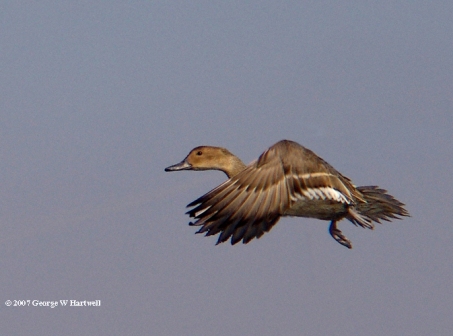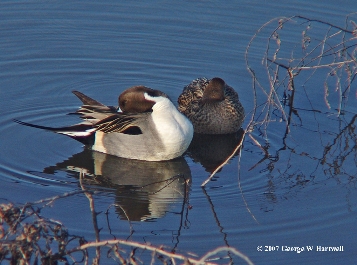Reproduction
Reproduction for the Pintail begins in
December when the mostly unisexual flocks
merge and the courting rituals begin.
Usually mates are renewed from year to year
but for those in their first year, when
breeding begins for pintails, or who are in
want of a new mate, extensive aerial and
aquatic courtship rituals take place, partly
because the number of males far surpasses
the number of females. Unlike some duck
species, the female plays an essential role
in the choosing of a mate. The male will
perform the preeni ng, head shaking, burping,
grunt whistling, head-up-tail-up, or turning
the back of the head that is customary
during such rituals. The female then makes
the decision of which male to choose based
off of these displays. When several males
are competing for one female, she will
usually pick the one that first arrived and
tried to establish a relationship before the
others. When it comes time to copulate the
ducks head to the water. The male then gives
a precopulatory head pump and mounts by
grasping the nape of the female. A bridling
display is performed by the male as he
prepares to dismount by drawing his head up
and back as he lets out a whistle.
ng, head shaking, burping,
grunt whistling, head-up-tail-up, or turning
the back of the head that is customary
during such rituals. The female then makes
the decision of which male to choose based
off of these displays. When several males
are competing for one female, she will
usually pick the one that first arrived and
tried to establish a relationship before the
others. When it comes time to copulate the
ducks head to the water. The male then gives
a precopulatory head pump and mounts by
grasping the nape of the female. A bridling
display is performed by the male as he
prepares to dismount by drawing his head up
and back as he lets out a whistle.
When the mates are chosen and it comes
time to nest, pintails tend to nest up to
half a mile from water, farther than most
other duck species. Pintails are ground
nesters and use plant growth, dead or alive,
for cover and are among the first of the
ducks to breed. Typically females lay
between seven and nine creme or yellow-green
eggs per nest, averaging 55 X 38 mm in size.
Contrary to other similar species of ducks,
pintails are considered to be very
successful re-nesters if their first nest is
lost. This loss could be do to predation,
especially skunks, which are major
predators
of all ground nesting ducks. The pintail
does very little to conceal its nests,
making it an easy target for skunks and
other predators that find their food
visually. Incubation begins once all of; the
eggs are laid and will hatch 22-23 days
later. It is not uncommon for people to be
able to walk right up to nests without the female taking flight because of the
incredible protection the females provide to
their young. Males offer some assistance but
are much less defensive and often spend a
lot of time with other males. The young will
be able to fly in 46 to 47 days, although it
is believed that this can happen four to
five days sooner in the northern breeding
areas due to more extensive daylight. The broods have a low mortality
rate (approximately 30%) due to the fact
that they are generally very mobile
the females are extremely defensive of their
young, more so than any other similar
species. Once the young are able to walk
they are led to the nearest water source and
learn to eat for themselves. The mother will
stay with the young until she re-grows her
flight feathers.
and will hatch 22-23 days
later. It is not uncommon for people to be
able to walk right up to nests without the female taking flight because of the
incredible protection the females provide to
their young. Males offer some assistance but
are much less defensive and often spend a
lot of time with other males. The young will
be able to fly in 46 to 47 days, although it
is believed that this can happen four to
five days sooner in the northern breeding
areas due to more extensive daylight. The broods have a low mortality
rate (approximately 30%) due to the fact
that they are generally very mobile
the females are extremely defensive of their
young, more so than any other similar
species. Once the young are able to walk
they are led to the nearest water source and
learn to eat for themselves. The mother will
stay with the young until she re-grows her
flight feathers.